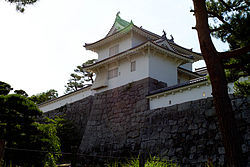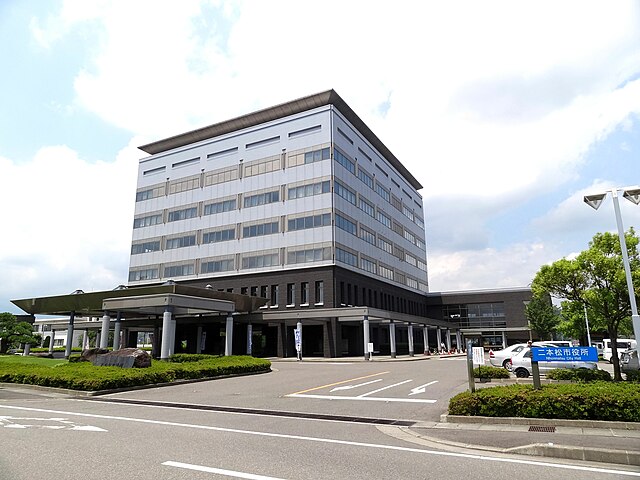Nihonmatsu, Fukushima
City in Tōhoku, Japan From Wikipedia, the free encyclopedia
City in Tōhoku, Japan From Wikipedia, the free encyclopedia
Nihonmatsu (二本松市, Nihonmatsu-shi) is a city in Fukushima Prefecture, Japan. As of 1 April 2020[update], the city has an estimated population of 54,013 in 20,179 households,[1] and a population density of 160 persons per km2. The total area of the city was 344.42 square kilometres (132.98 sq mi). The Adachi neighborhood of Nihonmatsu was the birthplace of artist Chieko Takamura, subject of the book of poems Chieko's Sky (智恵子抄, Chiekoshō, literally "Chieko Selections"), written by her husband Kōtarō Takamura.[2]
Nihonmatsu
二本松市 | |
|---|---|
 Minowa Gate in Nihonmatsu Castle | |
 Location of Nihonmatsu in Fukushima Prefecture | |
| Coordinates: 37°35′5.5″N 140°25′52.2″E | |
| Country | Japan |
| Region | Tōhoku |
| Prefecture | Fukushima |
| First official recorded | 769 AD |
| City settled | October 1, 1958 |
| Government | |
| • Mayor | Hiroshi Shinno |
| Area | |
| • Total | 344.42 km2 (132.98 sq mi) |
| Population (April 2020) | |
| • Total | 54,013 |
| • Density | 160/km2 (410/sq mi) |
| Time zone | UTC+9 (Japan Standard Time) |
| Phone number | 0243-23-1111 |
| Address | 403-1 Kanairo, Nihonmatsu-shi, Fukushima-ken 964-8601 |
| Climate | Cfa |
| Website | Official website |
| Symbols | |
| Bird | Japanese bush warbler |
| Flower | Chrysanthemum |
| Tree | Sakura |

Nihonmatsu is located in the Nakadōri section of Fukushima prefecture, between the cities of Fukushima and Kōriyama. It is approximately 250 km from central Tokyo. Nihonmatsu's western border consists of the Adatara mountain range. The Abukuma River runs through the eastern part (forming the border between the former towns of Adachi and Tōwa), flowing from south to north.
Nihonmatsu has a humid subtropical climate (Köppen Cfa) characterized by mild summers and cold winters with heavy snowfall. The average annual temperature in Nihonmatsu is 12.0 °C. The average annual rainfall is 1215 mm with September as the wettest month. The temperatures are highest on average in August, at around 25.0 °C, and lowest in January, at around 0.3 °C.[3]
| Climate data for Nihonmatsu (1991−2020 normals, extremes 1976−present) | |||||||||||||
|---|---|---|---|---|---|---|---|---|---|---|---|---|---|
| Month | Jan | Feb | Mar | Apr | May | Jun | Jul | Aug | Sep | Oct | Nov | Dec | Year |
| Record high °C (°F) | 16.6 (61.9) |
19.9 (67.8) |
24.1 (75.4) |
30.2 (86.4) |
34.7 (94.5) |
35.3 (95.5) |
37.7 (99.9) |
38.0 (100.4) |
35.9 (96.6) |
31.4 (88.5) |
23.7 (74.7) |
19.3 (66.7) |
38.0 (100.4) |
| Mean daily maximum °C (°F) | 5.4 (41.7) |
6.5 (43.7) |
10.4 (50.7) |
16.8 (62.2) |
22.4 (72.3) |
25.2 (77.4) |
28.4 (83.1) |
29.8 (85.6) |
25.4 (77.7) |
19.6 (67.3) |
13.9 (57.0) |
8.1 (46.6) |
17.7 (63.8) |
| Daily mean °C (°F) | 0.8 (33.4) |
1.5 (34.7) |
4.8 (40.6) |
10.6 (51.1) |
16.1 (61.0) |
19.7 (67.5) |
23.4 (74.1) |
24.4 (75.9) |
20.3 (68.5) |
14.3 (57.7) |
8.4 (47.1) |
3.3 (37.9) |
12.3 (54.1) |
| Mean daily minimum °C (°F) | −3.3 (26.1) |
−3.1 (26.4) |
−0.4 (31.3) |
4.7 (40.5) |
10.4 (50.7) |
15.2 (59.4) |
19.6 (67.3) |
20.6 (69.1) |
16.3 (61.3) |
9.7 (49.5) |
3.4 (38.1) |
−1.0 (30.2) |
7.7 (45.8) |
| Record low °C (°F) | −12.6 (9.3) |
−12.5 (9.5) |
−10.6 (12.9) |
−5.2 (22.6) |
1.0 (33.8) |
5.6 (42.1) |
9.5 (49.1) |
11.3 (52.3) |
4.3 (39.7) |
−1.7 (28.9) |
−4.6 (23.7) |
−12.3 (9.9) |
−12.6 (9.3) |
| Average precipitation mm (inches) | 42.5 (1.67) |
34.0 (1.34) |
74.0 (2.91) |
86.8 (3.42) |
91.5 (3.60) |
125.5 (4.94) |
185.5 (7.30) |
145.9 (5.74) |
166.6 (6.56) |
137.6 (5.42) |
58.8 (2.31) |
40.7 (1.60) |
1,189.3 (46.82) |
| Average precipitation days (≥ 1.0 mm) | 7.2 | 6.4 | 8.8 | 8.4 | 9.6 | 11.3 | 14.1 | 11.6 | 11.7 | 8.9 | 6.5 | 7.3 | 111.8 |
| Mean monthly sunshine hours | 132.7 | 142.7 | 162.7 | 175.4 | 181.7 | 129.0 | 122.0 | 149.5 | 121.1 | 129.9 | 126.5 | 126.2 | 1,703.4 |
| Source: Japan Meteorological Agency[4][5] | |||||||||||||
Per Japanese census data,[6] the population of Nihonmatsu peaked around 1950 and has since declined to pre-1920s levels.
| Year | Pop. | ±% |
|---|---|---|
| 1920 | 59,895 | — |
| 1930 | 63,929 | +6.7% |
| 1940 | 64,775 | +1.3% |
| 1950 | 79,215 | +22.3% |
| 1960 | 75,634 | −4.5% |
| 1970 | 68,117 | −9.9% |
| 1980 | 66,709 | −2.1% |
| 1990 | 66,988 | +0.4% |
| 2000 | 66,077 | −1.4% |
| 2010 | 59,871 | −9.4% |
| 2020 | 53,557 | −10.5% |
The area of present-day Nihonmatsu was part of ancient Mutsu Province. It developed as post station on the Ōshū Kaidō highway and as the castle town of Nihonmatsu Domain, a 100,700 koku han, which was ruled by the Niwa clan under the Tokugawa shogunate) in the Edo period. After the Meiji Restoration, it was organized as part of Adachi District in the Nakadōri region of Iwaki Province.
The town of Nihonmatsu was established with the creation of the modern municipalities system on April 1, 1889. Nihonmatsu annexed the neighboring villages of Shiozawa, Dakeshita, Sugita, Ishii and Ohdaira on January 1, 1955 and was elevated to city status on October 1, 1958. The city annexed the towns of Adachi, Iwashiro and Tōwa (all from Adach District) on December 1, 2005.[7]
Nihonmatsu has a mayor-council form of government with a directly elected mayor and a unicameral city legislature of 26 members. Nihonmatsu contributes two members to the Fukushima Prefectural Assembly. In terms of national politics, the city is part of Fukushima 2nd district of the lower house of the Diet of Japan.
Nihonmatsu is a regional commercial center with a mixed economy. It is especially noted for furniture manufacturing and sake brewing.
Nihonmatsu has 16 public elementary schools and seven public junior high school operated by the city government, and three public high schools operated by the Fukushima Board of Education.

Nihonmatsu has a long history of sake brewing, with several sake breweries headquartered in the city:
Seamless Wikipedia browsing. On steroids.
Every time you click a link to Wikipedia, Wiktionary or Wikiquote in your browser's search results, it will show the modern Wikiwand interface.
Wikiwand extension is a five stars, simple, with minimum permission required to keep your browsing private, safe and transparent.